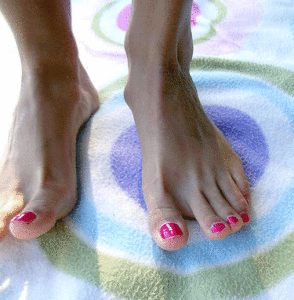 Anyone who stands all day at work is probably accustomed to having sore, achy feet at the end of the day, and runners may know the familiar heel pain after a long run. For some people however, that initial ache can develop into a more serious concern called plantar fasciitis. Plantar fasciitis is the most common type of foot pain, and occurs when the flat band of tissue connecting your heal to your toe, called the plantar fascia, is strained. Tiny tears in the tissues of the plantar fascia develop, causing inflammation and pain at the bottom of the foot when walking, standing, or getting out of bed in the morning.
Anyone who stands all day at work is probably accustomed to having sore, achy feet at the end of the day, and runners may know the familiar heel pain after a long run. For some people however, that initial ache can develop into a more serious concern called plantar fasciitis. Plantar fasciitis is the most common type of foot pain, and occurs when the flat band of tissue connecting your heal to your toe, called the plantar fascia, is strained. Tiny tears in the tissues of the plantar fascia develop, causing inflammation and pain at the bottom of the foot when walking, standing, or getting out of bed in the morning.
Plantar fasciitis frequently develops in workers after prolonged periods of standing on hard surfaces or in athletes due to overtraining. Additional causes include improper footwear, being overweight, having high arches or flat feet, or rolling your feet inward as you walk. Plantar fasciitis is more common in women and middle-aged adults.
While taking anti-inflammatory medications can help to decrease foot pain, these medications only temporarily ease symptoms. What should you do if movement is an essential component of your daily life, such as an athletes or workers who stand?
Here are five tips for preventing plantar fasciitis foot pain:
1. Get a postural analysis. Your pain may be related to your gait, or how you carry your weight while walking. People who turn their feet inward too much (overpronation) or outward too much (underpronation), and those who have high arches or flat feet are at a higher risk of plantar fasciitis. This can often be corrected by orthotics, posture correction, and chiropractic adjustments. As a chiropractor trained in sports medicine and skilled in treating sports injuries, Dr. Rivano can perform a postural analysis to see if your posture or gait can be improved.
2. Make sure you have the right-fitting shoes. Improper footwear is a common cause of foot pain, heel pain, and plantar fasciitis. If you have flat feet, getting insoles or shoes with arch support can help to absorb shock. However, if you have a high arch, additional support may create more problems, so workers will want to wear flat, cushion-like insoles. Your Florham Park chiropractor, Dr. Rivano, can advise you on using proper footwear.
3. Stretch. Regularly stretching your toes, feet, and calves throughout the day and especially before work or engaging in physical activity can help to prevent plantar fasciitis pain. The feet are supported by the calf muscles and Achilles tendons, so it's important to incorporate additional lower limb stretches into your at-home care. There are also particular exercises which can help to strengthen the plantar fascia and supporting muscles. Consult with Florham Park chiropractor Dr. Rivano for stretches appropriate for your needs.
4. Ice and cryotherapy. Cold therapy (known as cryotherapy) can soothe inflammation and decrease pain. As a sports injury chiropractor, Dr. Rivano frequently advises patients on using cryotherapy to reduce acute and chronic pain.
5. Rest. Finally, it's important to rest your feet during periods of heightened plantar fasciitis foot pain to avoid damaging the tendon further. If you're an athlete, take a break from running or walking and use a lower-impact exercise for cardio, like swimming or cycling. If you're a worker who stands, ask if you can temporarily switch to tasks that get you off your feet or take short sitting breaks throughout the day. Over time, your injured tendon will heal and you will be able to resume normal activities.
6. Consider getting Extracorporeal Pulse Activation Treatment (EPAT). We've previously written about how EPAT can ease a range of musculoskeletal problems by increasing blood circulation and stimulating the metabolism to support healing. Dr. Rivano specializes in using this non-invasive treatment for foot pain relief and more.
Don't let plantar fasciitis get in the way of your ability to work or participate in sports. Give Rivano Chiropractic Health Center a call for relief from plantar fasciitis in Florham Park, Madison, and East Hanover today.
Photo by Chris Bögle via Creative Commons
References
Daniels CJ and Morrell AP. Chiropractic management of pediatric plantar fasciitis: a case report. Journal of Chiropractic Medicine 2012; 11(1): 58-63. doi: 10.1016/j.jcm.2011.06.009.
Preventing Foot Pain in the Workforce. Foot Protection Content from EHS Today. November 17, 2003. Accessed October 16, 2013. http://ehstoday.com/ppe/foot-protection/ehs_imp_36713